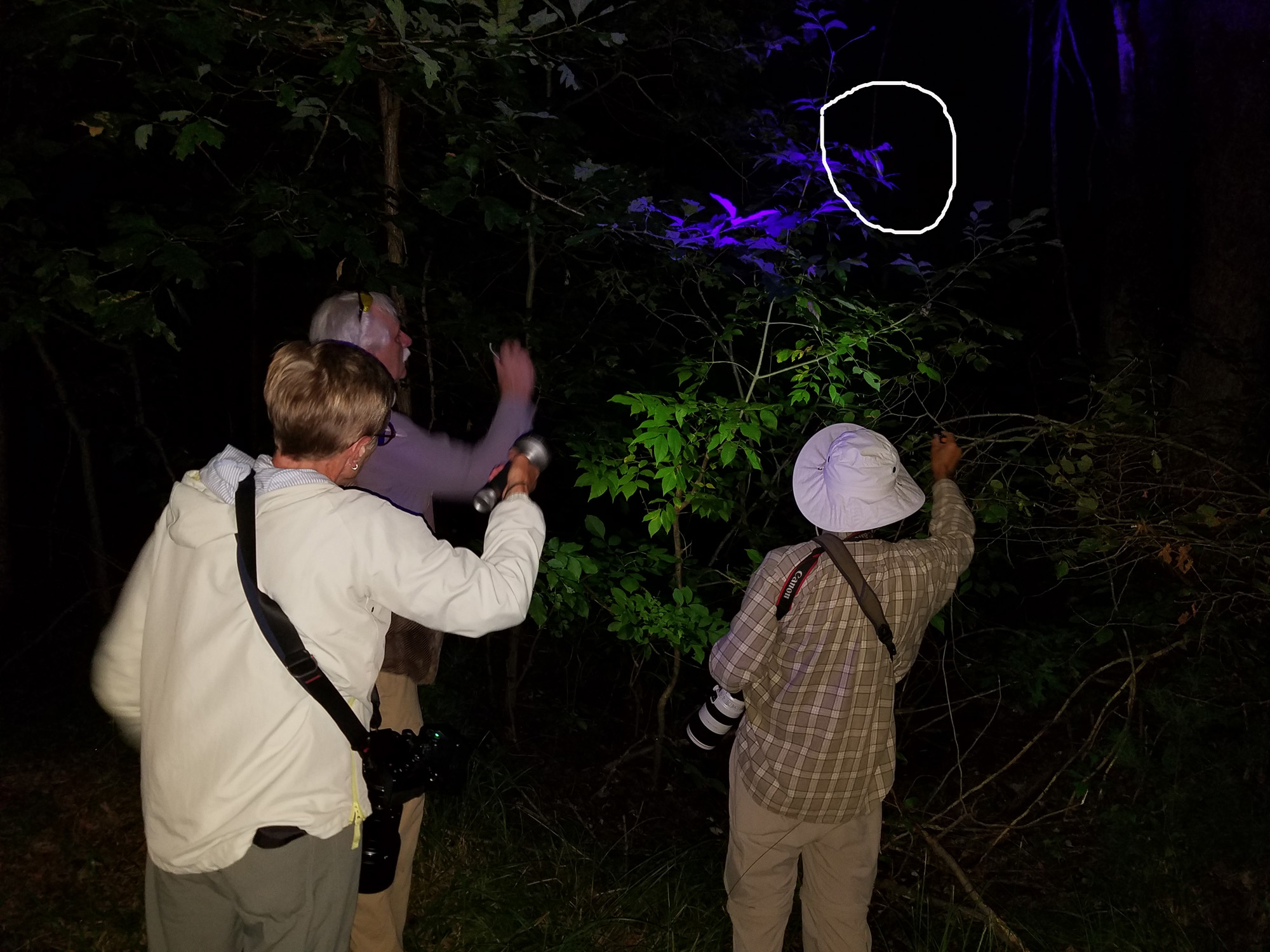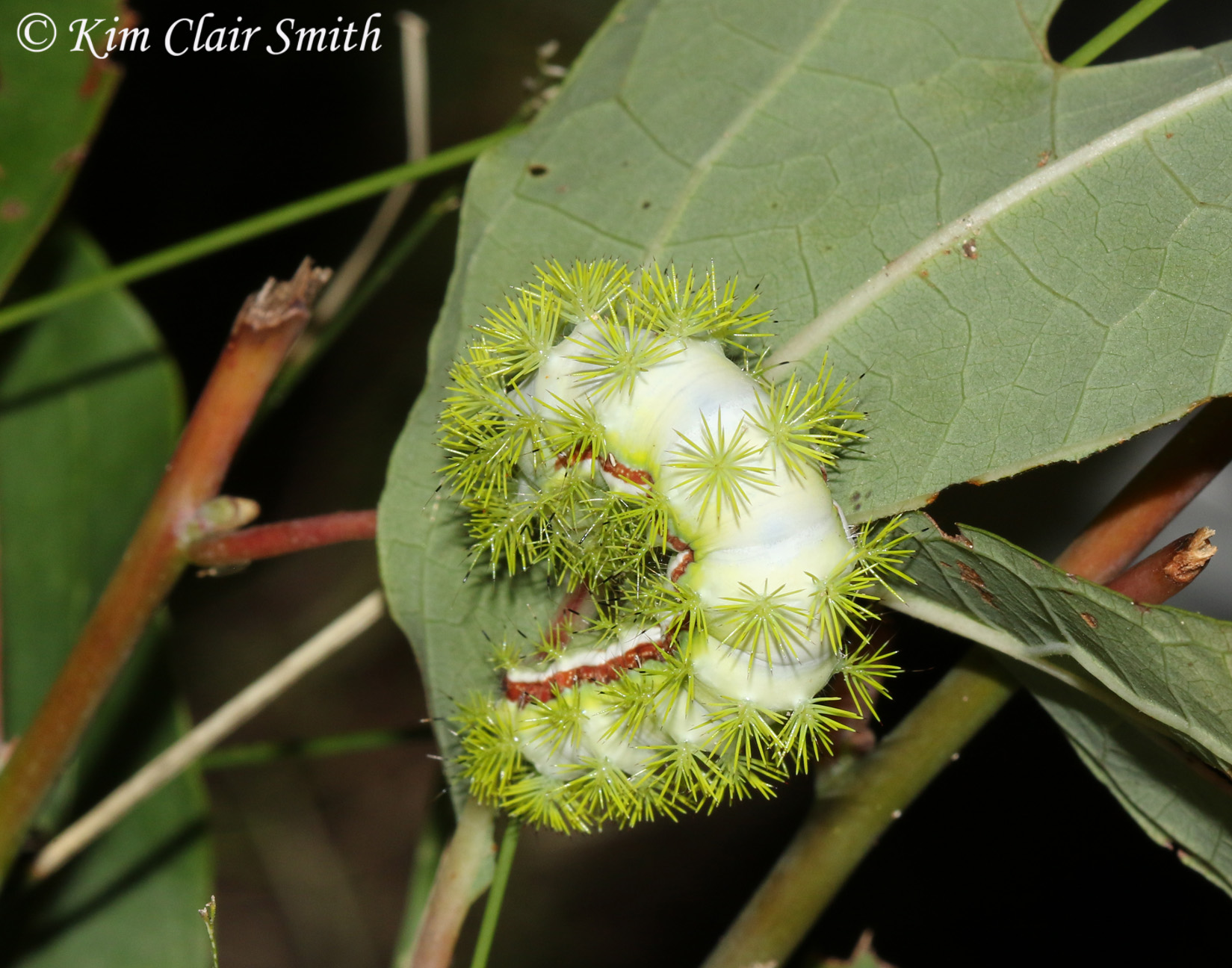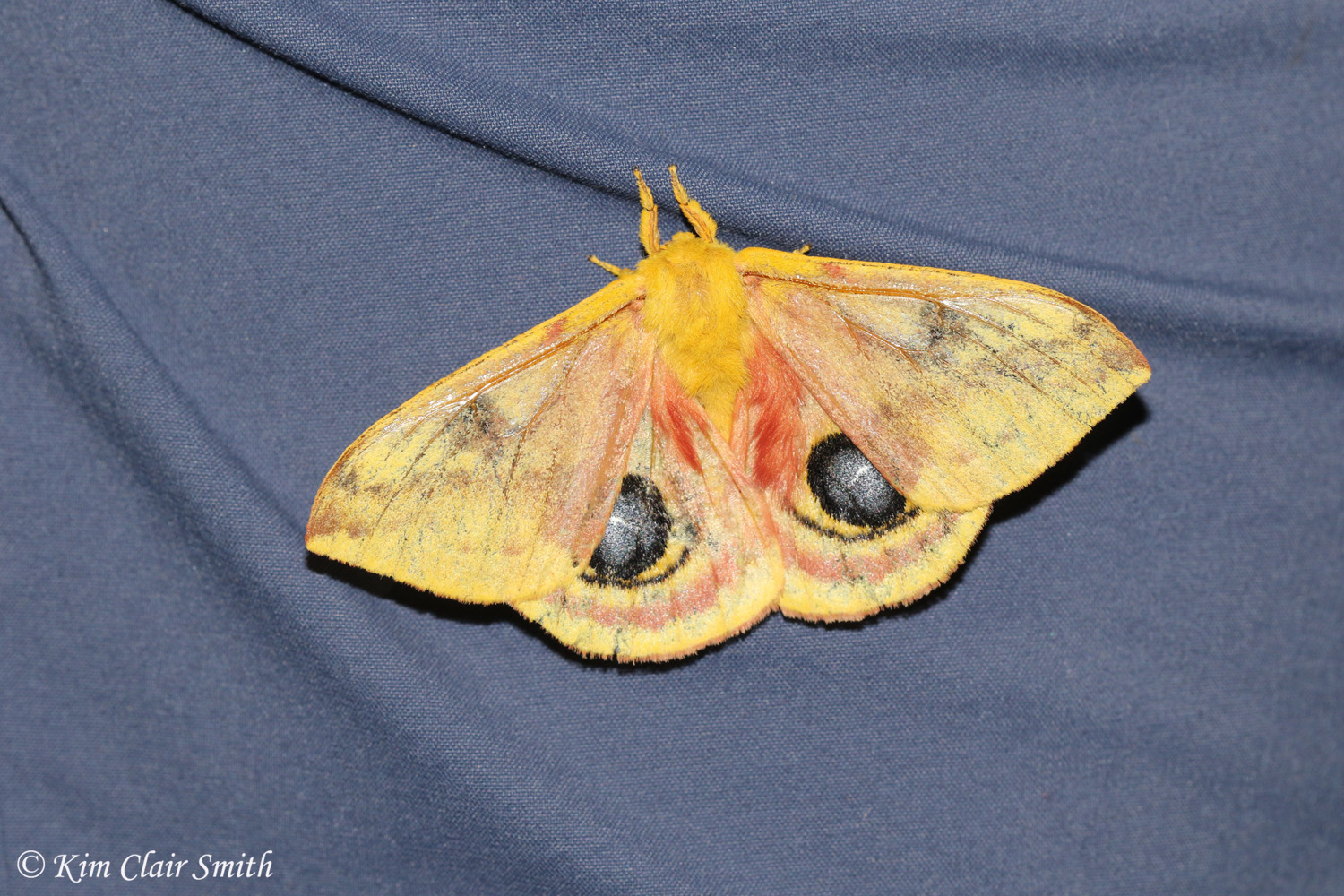I promised you some really cool pics recently, and then I got distracted and wrote about my dragonfly monitoring. But now I’m refocused and I think you’re going to enjoy this!
In July I wrote about how much fun I had staying out at night to look at moths in southern Ohio. Recently I’ve become hooked on another nighttime activity here in the opposite corner of the state. Along with a small group of friends, I’ve been going out to hunt caterpillars and other insects by flashlight. These night hikes have been hugely entertaining, and I think you’ll be amazed at the creatures I have to show you. Keep in mind as you look at these photos that these are not exotic animals from the rainforests of Central America or the outback of Australia. These are all local critters, living right here in northwest Ohio.

Many caterpillars are more active at night, so that’s a great time to go out with a UV flashlight to observe them. Believe it or not, some of them glow when you shine the black light on them. This makes it much easier to find them in the dark than when they’re camouflaged in vegetation during the day. So we start our outings as soon as it gets dark, and stay out until we’re too tired to keep going. There’s always so much to see that I hate to stop, even when I’m exhausted.
Notice the white circle in the photo above. The caterpillar (“cat” for short) in that shot is this one, which I think is a Waved Sphinx Moth cat. Here it is:

I’ve had some challenges trying to photograph these cats in the dark. On the first outing, I tried using an old ring flash unit on my 100mm macro lens, but didn’t get good results with that and was frustrated. Then I removed the ring flash and just used the built-in flash on my camera. The problem with that is that the camera can’t focus unless you also light the subject with additional light. So I was holding a flashlight in one hand and camera in the other. That was better, but awkward. My friend Jackie tried holding a small flashlight in her mouth! That worked but wasn’t optimal. So some of us took turns holding flashlights for each other, and that was much better, especially once I got my other camera settings adjusted properly.
Several of my friends have nice twin light flash units, and those seem to be the way to go for this type of photography. Those units have a flash on top, but also extra lights on each side that light the subject so you can focus before the flash goes off. I think I’m going to try to get one of those before our next outing so I can be more self-sufficient and not need someone else to hold a flashlight for me every time I want to take a photo.
Okay, that’s enough of the technical stuff. You wanna see some of the awesome things we found? Let’s start with one of the best ones, the Io moth caterpillar. Isn’t he gorgeous?!

During Mothapalooza back in July, an adult Io moth posed for photos on my friend Angie’s pant leg:

I find it fascinating that the caterpillar forms and the adult moth forms seem to have nothing in common in terms of color or pattern. In this case, the caterpillar is white with green spines and red stripes, and it turns into a yellow moth with black and orange markings.
This next one was the highlight of my night when we found it. I’d seen it online many times and hoped to see one for myself for a long time. This is the Saddleback caterpillar, and it has venomous spines that can cause severe burning and blistering if you touch it. So we didn’t. (In fact, there are many caterpillars with spines or long hairs, and most of them can can cause you varying levels of pain if you touch them.)

The first Saddleback we saw that night was on a leaf above our heads, and we had to contort ourselves to get photos of it. But I was amazed at how tiny it was. When you see pictures of caterpillars online or in a book, it’s hard to get perspective on their true sizes. From what I’d seen online, I guess I thought this thing would be four inches long, but it was less than an inch from end to end. Such a crazy-looking insect! And when it metamorphoses into its adult moth form, it will be so much less striking, just a dull brown with a couple of white spots.
This next one was much beefier, and we found a lot of them feeding on sassafras trees, one of their favorite host plants. This is the larval form of the Promethea moth:

I’ve never seen the adult form of this moth (yet), but it’s one of the large silk moths, with pretty patterning in shades of brown and white. I hope to see it at Mothapalooza next time.
Most of the cats we found were the larvae of moths, but here’s one of the butterfly larvae. This is the Tiger Swallowtail caterpillar, with fake eyes that are supposed to scare predators away.

Next up…hmm. Nothing to see here, just us sticks! Don’t be fooled by this stick mimic caterpillar, with his ingenious camouflage technique. There are lots of this type and I haven’t figured out which one this is, but I find these so fascinating.

As I write this, I’m having a hard time choosing which ones to show you…I have a hundred photos of caterpillars and other insects from these hikes. I should probably write a book called, “Creatures of the Night” so I can share all of them in one place. And I’m getting immense pleasure out of looking at these photos again, because it brings back the joy of discovery and being out in nature at night with nothing but a few flashlights to illuminate our surroundings. On the first outing I was surprised at how giddy I felt, like a kid being allowed to stay out after the streetlights come on. Think about it though, when is the last time you were outside after dark in the woods? Yeah, that’s what I thought. It’s just not something most of us do anymore, and that’s a shame because there’s so much out there to enjoy.

The sphinx moth caterpillars are distinctive, with their diagonal slashes and horns (some of them are also called hornworms). I just found out the reason they’re called sphinx moths; it’s because when they’re disturbed they often lift their heads up in a sphinx-like defensive posture.
And here’s another cool one, the White Furcula moth. (He’ll be white in his moth form.) Check out that long forked “tail” appendage!

That forked appendage is one of his primary defenses, as he can pump fluid into it to lengthen it enough that it can slap down in front of his head to (hopefully) deter a predator. Honestly, you can’t make this stuff up!
Did you know that birds need extremely high numbers of caterpillars to raise their babies? We think we’re helping the birds by providing seed in feeders, but that only helps the adult birds. Baby birds can’t eat seeds; they need soft food with a high protein content. And that usually means caterpillars. In fact, one pair of chickadees will need to deliver up to 9,000 caterpillars to their chicks before they can leave the nest. That’s just one pair! So if you really want to help the birds raise their families in your yard, you’ll want to grow as many native plants as possible. (That’s because native plants support many more caterpillars than non-native plants do; I need to write more about that soon too.)
Most caterpillars don’t survive to become adult moths or butterflies, in fact. That probably explains their many ingenious defensive adaptations, from poisonous spines to fake eyes to pretending to be a stick — anything to try and avoid becoming a bird’s next meal.

Okay, that’s probably enough to give you an idea of how much fun it can be to look for stuff in the woods at night. Oh, and as I mentioned above, it’s not just about caterpillars. We found lots of cool crickets, spiders, and frogs, like this adorable spring peeper!
And this last photo shows how excited I was to be out there in the dark, hunting tiny insects with my friends. What a dork! But I can’t wait for our next foray into the night.


What an amazing night adventure and fantastic photos. You were right that we would enjoy these. Hope you have another posting with more of what you saw.
LikeLike
Glad you enjoyed it, Annie! I might be able to do another one sometime soon. 🙂
LikeLike
Wow! Who knew, right? Now I want to try this! Great photos and lovely text.
LikeLike
I do hope you’ll try it, Cindy. And write about it, of course!
LikeLiked by 1 person
I happen to LOVE dorks!! Ha ha! You have some great images here, Kim. Some of these I have never seen before. It’s amazing what adventure unfolds in the dark of night.
LikeLiked by 1 person
Amazing & Great Images Kim! Plus all the info you gave us!
LikeLiked by 1 person
I am delighted that you share your dorkdom with us. I learn a lot and immensely enjoy your outings vicariously.
LikeLike
Thanks, Lisa!
LikeLike
Wow, beautiful pictures.
And what a good idea to go caterpillar hunting by night. I have no idea if we have that kind of interesting animals over here (in Germany), but you never know before you go for a little explorating…..
LikeLiked by 1 person
I just googled “caterpillars in Germany,” and found lots of articles about a plague of toxic processionary caterpillars — yikes! (Here’s one of them: https://www.bbc.com/news/world-europe-48880468) I did another search to exclude those articles, and found lots of really awesome caterpillars in Germany! Here’s the link to my search results : https://www.google.com/search?rlz=1C1CHBF_enUS775US775&sxsrf=ACYBGNSEgSCbkHwQ9b65Q_WkAEK3BxnDVg:1569252821369&q=moth+caterpillar+germany+-toxic+-processionary&tbm=isch&source=univ&sa=X&ved=2ahUKEwjM0eunoufkAhUGlawKHe3lBUgQsAR6BAgJEAE&biw=1422&bih=642
LikeLiked by 1 person
Yes, you’re right! We do have beautiful caterpillars here. I’m just not sure if they glow by night, if you use UV light.
But we have a small UV flashlight, so we might just have a look 🙂
LikeLike
Those are some cracker shots, Kim. We have some pretty amazing insects here too, but I would have never guessed Ohio had those little beauties. We have a stick caterpillar here that I’ve seen but not photographed. Thanks for sharing your knowledge and photos.
LikeLiked by 1 person
Thanks, Ardys. I just did a quick search for caterpillars in Australia and you do indeed have some cool ones. The one that seems most stunning to me is the wattle cup caterpillar — my gosh!!!
LikeLike
Yes, you really have to wonder what Mother Nature was thinking with that one!
LikeLike
Kim-
Great photos- proof you don’t need to go around the world to see amazing things!
take care, daryl
LikeLiked by 1 person